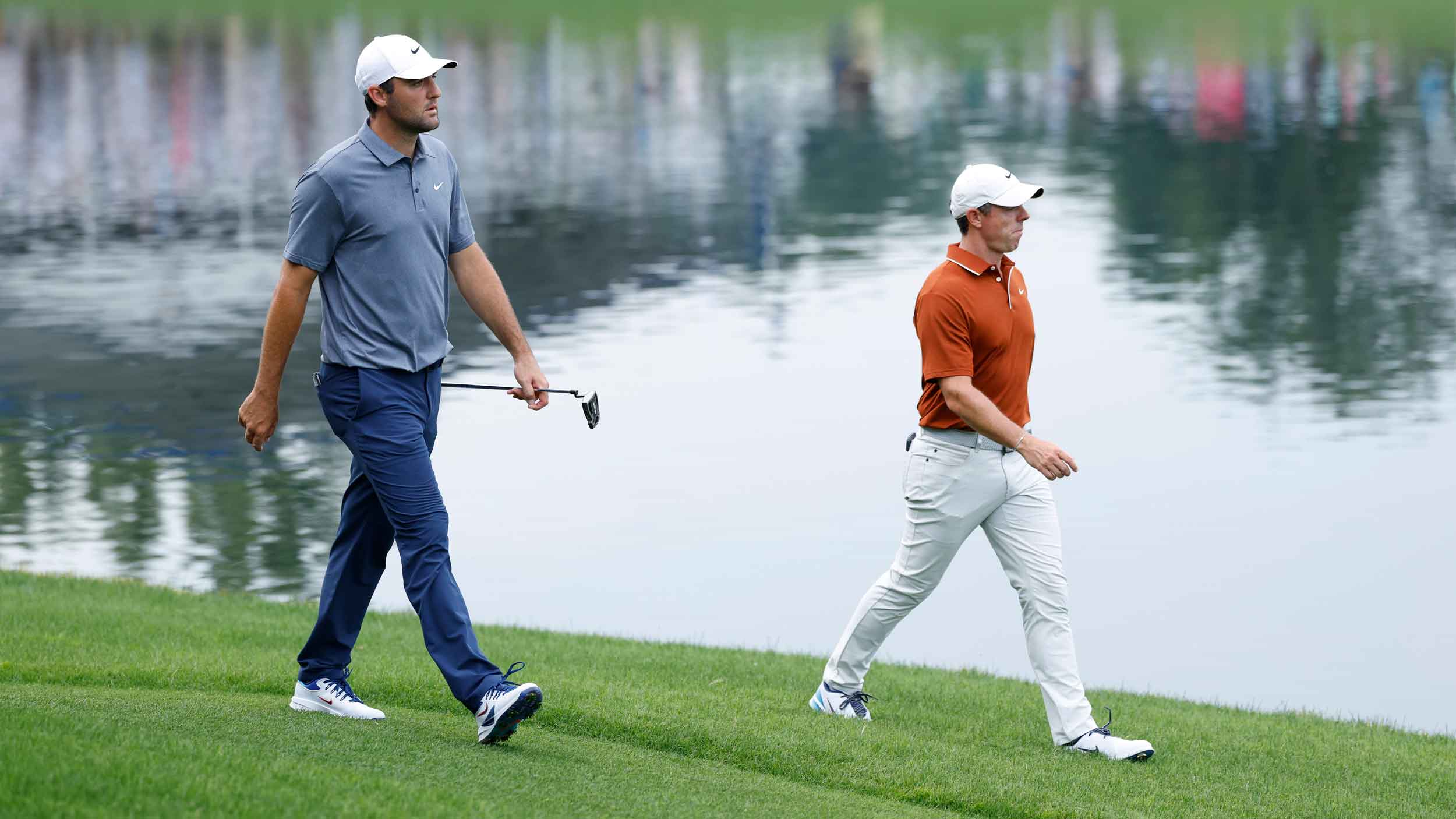Jon Rahm lost the PGA Championship, but it didn't look that way from up close
CHARLOTTE, N.C. — No WAY that was a 73. Couldn’t have been! It was too good. Too eerie. Way too much turning-the-crowd-against-Scottie for that round to be any higher than a 68…right?
Well, somewhere on Quail Hollow’s finishing stretch, you saw Jon Rahm’s eyes turn from steely to staid and his power fades to straight balls. You saw his Callaway shoot left on 16, and then get gusted into the water on 17, and then bound into the creek on 18. It doesn’t take a math whiz. You saw him cover his mouth and flip his putter into the air and furiously slam his driver head into the ground once, twice, three times as he left the 18th tee. You even heard a spectator shout “Snap it!” and when you looked up, Rahm had his hands on each end of the club, daring the shaft to give up and break.
So yeah — somehow the round that nearly stole the PGA Championship tallied up to two-over-par 73, seven shots back of the biggest thorn in Rahm’s side, Scottie Scheffler, who is two years younger and now one major richer.
Sometimes leaderboards tell you everything. This one will lie to us for years. Because as Davis Riley (T2) was chunking wedges into hazards and while Bryson DeChambeau earned himself a second-straight major top 5, and as Harris English won himself a boatload of money ($1.41 million), it was Rahm alone who breathed life into this tournament. It seemed to breathe life into him as a golfer, too.
“God, it’s been a while since I had that much fun on a golf course,” he said afterward. Those words won’t look great to a LIV executive, but they’ve got everything to do with major championship golf. The kind that can flip legacies like a coin. Rahm began the day five back and opened with seven solid, sleepy pars. But as Scheffler slowly backed up with a wobbly left-miss, Rahm birdied 8, 10 and 11 in a 45-minute frenzy. Suddenly, they were tied.
THIS WEEK WAS AN EXERCISE IN MARGINS, NO? Most of the weekend was wasted on the topic of driver heads. The clubs are designed with the thinnest metal that — when hit a thousand times — creates a trampoline effect the sport has deemed illegal. Why? Because it might get you another yard or two. If you can promise it’ll go straight, pro golfers would love an extra yard or two. But the closer you get, the more chaotic the returns. Just ask Rory McIlroy.
This week the margins were in the dirt. If your golf ball grabbed enough of the sticky stuff from the rain-soaked fairways at Quail Hollow, you were left to the whims of mud-ball physics. Dirt on the left side of the ball, it’ll probably go right. Right side, it’ll probably go left. Players do whatever they can to avoid the chaotic margins, building robotic swings to hit the perfect shot with the perfect club choice, while judging the wind or the break or the pace perfectly. But sometimes, the margins hold your fate. Rahm will have to accept that the margins betrayed him twice Sunday.
The first came on that creeping putt he hit on 13, which grabbed so much of the cup that it might have dropped if the barometric pressure in Charlotte was any lower. The second came just a moment later, when his drawing tee ball on the drivable 14th — where the green angles mostly left — mysteriously kicked forward and into the bunker. He failed to get up and down for birdie. Rahm nearly dropped to his knees on both of those shots. Either would have sent an audible message to Scheffler, just a couple of holes back, who later admitted he’d never worked so hard to win a golf tournament. That was because of Rahm.
For that sequence to finish par-par, and for the par-5 15th to squeeze away from him in another par, well, Rahm said it himself: “If there’s ever a time where it felt like it was slipping away to an extent, it was not birdieing 14 and 15; that was definitely the mistake, before, obviously, finishing poorly.”
Yes, finishing poorly. Only he actually finished differently than most people got to see.
Rahm trudged up the hill from 18, made his way toward the scoring room, but first caught an elongated, emotional hug from his wife, Kelley. When he emerged from signing for that 73, the man smashing his driver into the ground just 37 minutes earlier was shockingly stoic and impressively raw. He was asked to explain what happened down the stretch — was it bad swings, nerves, bad luck? — and he just sat back in the chair and smiled:
“If there’s ever somebody that’s sitting right here that tells you nerves weren’t a part of it, they’re clearly lying. It’s the main thing we do as a professional sport: controlling what goes through your mind.”
Rahm called out his faults. He wasn’t sure exactly why it happened, and so quickly. He rambled and then apologized for his long answers, limiting the number of questions we could get to. “I’m trying to process things right now,” he said. He said he was embarrassed by how he finished.
“But I just need to get over it, get over myself,” he said. “It’s not the end of the world. It’s not like I’m a doctor or a first responder, where somebody — if they have a bad day, truly bad things happen.
“I’ll get over it. I’ll move on. Again, there’s a lot more positive than negative to think about this week.”
As ever, this is a man in progress. Learning to cool down as quickly as he heats up. It’s worth remembering that Rahm fancies himself a student of the game. He’s forced his way into practice rounds with Phil Mickelson and begged for Augusta National intel from Tiger Woods. He’s lost count of how many old Masters broadcasts he’s watched on YouTube, and reminded us earlier this week of the info-packed Open Championship mini-docs produced by the R&A.
By cramming those videos into his free time, Rahm says he pocketed errant bits of advice from Woods and Padraig Harrington and, as he explained Tuesday, from Jack Nicklaus’ favorite memories of winning at Muirfield. Back when he made winning these majors look easy, Nicklaus liked to set a target score down the stretch that, if he could match it, he’d have a great chance to win.
Rahm on Tuesday: “I thought that was quite interesting.”
Rahm on Sunday: Let’s give it a try.
He figured under par over the last five holes would do it. That’s where it all went downhill, and quickly. A stupefyingly good 73 he’ll likely study for a while. We’d be smart to join him. There’s another exam next month, one he aced four years ago.
The post Jon Rahm lost the PGA Championship, but it didn’t look that way from up close appeared first on Golf.




